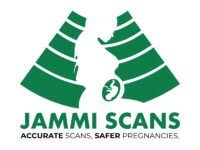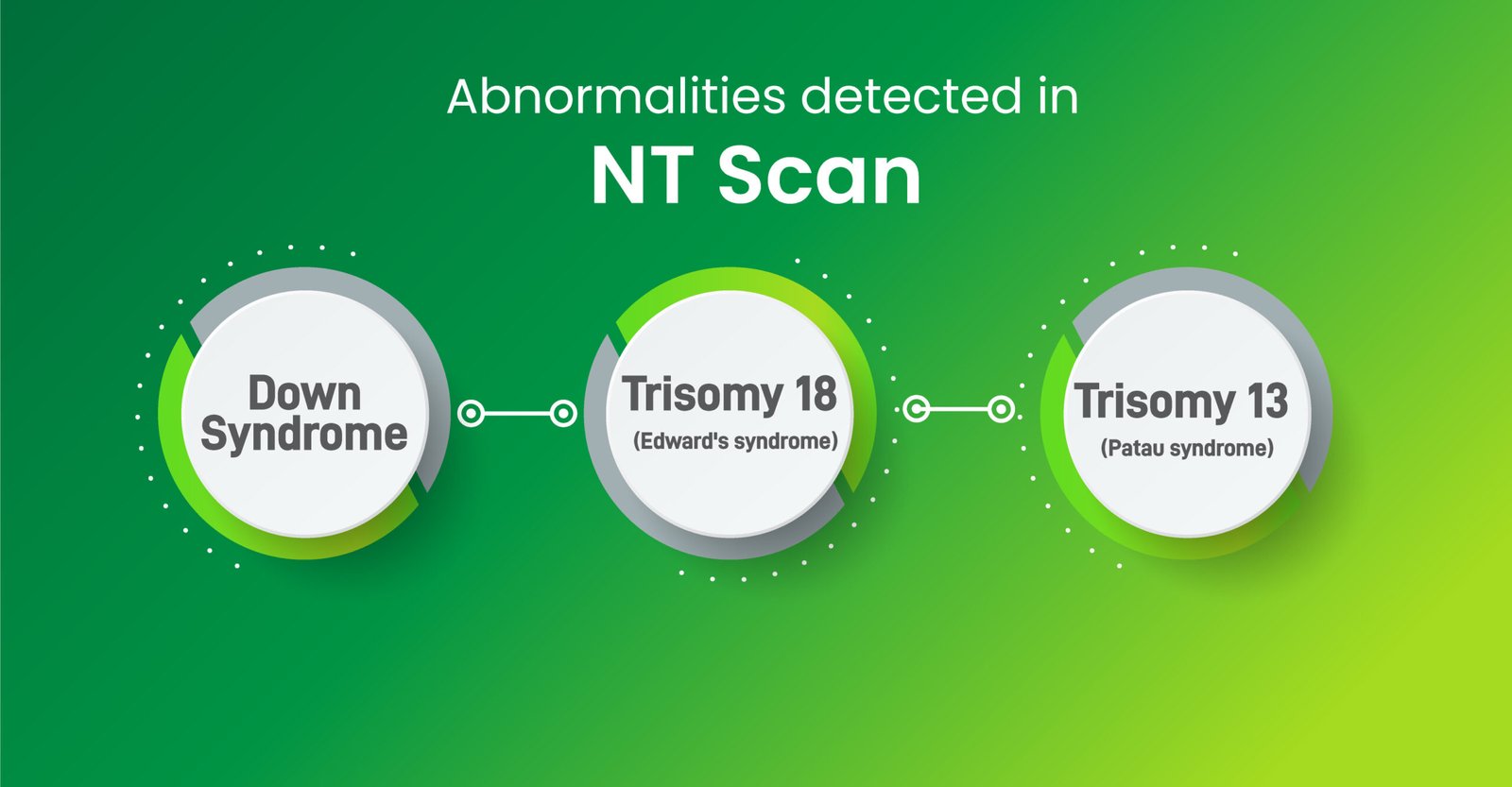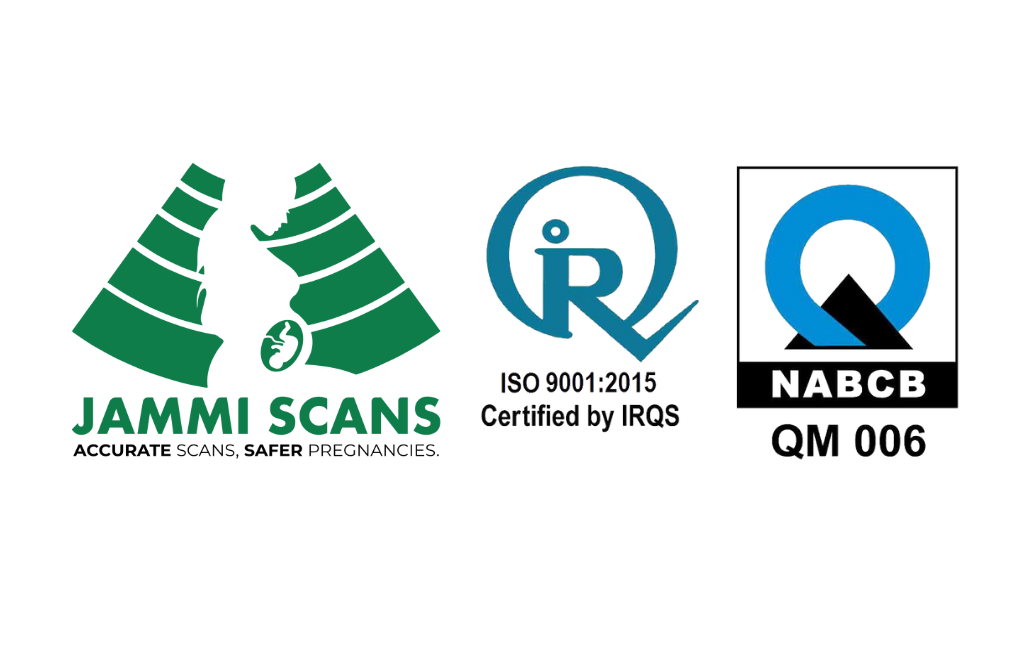Table of Contents
TogglePrenatal test: Nuchal Translucency scan abnormalities
The ultrasound NT scan taken in the first trimester basically determines your unborn’s risk of having Down syndrome and some other chromosomal abnormalities. This post is all about the abnormalities detected in the NT scan and how to handle them.
To the moms-to-be who have not yet crossed the milestone, their first anxiety will be on what if I receive an abnormal NT scan report?
The scan carries a lot of weightage, we agree, but there is nothing to panic about and stress yourself.
What are the abnormalities that can be detected in NT Scan?
The NT scan will check for the following chromosomal abnormalities.
Three types of Down Syndrome
Trisomy 21
Trisomy 21 is a genetic disorder brought on by an extra chromosome that is also referred to as Down syndrome.
Most babies receive 23 chromosomes from each parent, for a total of 46. Babies with Down syndrome, on the other hand, have three chromosomes at position 21, rather than the usual pair.
Translocation
In this form of Down syndrome, one or more copies of chromosome 21 are joined to another chromosome. Four percent of all cases are caused by translocation.
Mosaicism
In the most uncommon type of Down syndrome (1%), some cells have 46 and some have 47 chromosomes. This abnormality can affect any cell type, including blood cells.
Trisomy 18 (Edward’s syndrome)
Trisomy 18, is a very serious genetic disorder that affects how your child’s body grows and develops. Trisomy 18 is characterized by low birth weight, numerous birth defects, and distinctive physical traits.
Trisomy 13 (Patau syndrome)
A chromosome has an extra copy of chromosome due to the genetic condition known as trisomy. A trisomy patient has 47 chromosomes rather than 46. Although trisomy pregnancies frequently end in miscarriage, they can also result in a live birth.
Structural chromosome abnormalities
When a chromosome is structurally abnormal, a portion of it is either missing, extra, switched to another chromosome, or reversed including defects in the heart, abdominal wall, and skeleton.
The four main categories of structural chromosomal abnormalities include:
Deletions
Deletions occur when a portion of a chromosome is deleted or removed, making that chromosome less functional.
Translocations
Translocations happen when a piece of one chromosome breaks off from its original location and attaches to another.
Inversions
When a chromosome is inverted or flipped in the opposite direction, the genetic material is inverted.
Duplications
Duplication occurs when a portion of a chromosome is duplicated, resulting in extra genetic material.
How will the NT Scan report be when the baby is abnormal?
The result of a “normal” or “abnormal” NT scan report is based on the below or above-predetermined cutoff of the ratio set up.
Some tests, for example, use a cutoff of 1 in 250. So a result of 1 in 1,200 is considered normal because the risk of a problem is less than 1 in 250.
A risk of 1 in 100 is considered abnormal because it is greater than 1 in 250.
Remember that a normal screening result (screen negative) does not guarantee that your baby has normal chromosomes, but it does indicate that there is a low likelihood of a problem.
Similarly, an abnormal screening result (screen positive) does not imply that your baby has a chromosomal problem – it simply indicates that your baby has a chromosomal problem – simply that your child is more likely to have one.
The majority of screen-positive babies turn out to be normal: only about a third of babies with increased nuchal translucency measurements have chromosomal defects.
What to do if you get an abnormal NT scan report?
The NT scan by itself will detect approximately 70% to 80% of babies with Down Syndrome, depending on which study you look at.
The NT scan plus a first-trimester blood test has a detection rate of 79 to 90 percent.
This does not imply that a baby who tests positive has a 79 to 90 percent chance of having DS. It simply means that 79 to 90 percent of babies with Down syndrome will have screening results.
False negative findings
Screening tests are not without flaws. They do not detect all cases of Down Syndrome, so your baby may be labeled as low risk when they actually have Down Syndrome.
In other words, if you’re carrying a baby with Down Syndrome, there’s a 79 to 90 percent chance that the combined screening will detect the abnormality and give you a screen-positive result, indicating that additional testing is advised.
However, there is a 5 to 21% chance that the tests will miss Down Syndrome and give you a screen-negative result.
This is known as a false negative result, and it may cause you to forego diagnostic testing that would have revealed a problem.
False positive findings
There is also a 5% false-positive rate with these tests.
A false-positive result indicates that your baby is at increased risk for DS or another condition when there is none.
What to do if I get an abnormal NT scan report?
You’ll need to decide whether the results indicate a high enough risk to warrant CVS or amniocentesis to get a definitive diagnosis, with the help of your fetal medicine expert or gynecologist, or genetic counselor.
In your decision, you must consider your desire to learn about your baby’s ailment against the slight chance that diagnostic testing will result in a miscarriage.
If you opt out of diagnostic testing, you can learn more about your baby’s health and development by having NIPT (a blood test available to all pregnant women starting at 10 weeks), the quad screen (a blood test in the second trimester), and a detailed ultrasound at 18 to 20 weeks.
This ultrasound can detect “soft markers” of chromosome disorders like short limbs, a bright dot in the heart, a bright bowel, and certain kidney problems. It can also detect anatomical defects like spina bifida.
Chennai Women’s Clinic is now Jammi Scans
Deepthi
Dr. Deepthi Jammi (Director, Jammi Scans) is a qualified OB/GYN and Post-Doc in Maternal Fetal Medicine. As a pregnancy ultrasound expert, she is passionate about healthy pregnancies and works towards spreading awareness on the latest diagnostic options available for parents to choose from. Dr.Deepthi has received gold medals and awards in Fetal Medicine at international and national conferences, and has appeared in numerous prestigious regional magazines and TV interviews.






